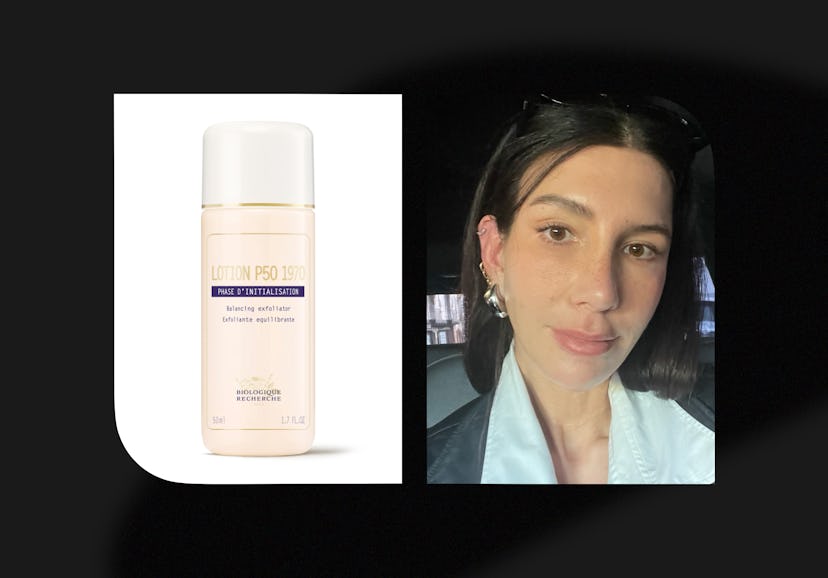Cult Classics
Gone, But Not Forgotten: Biologique Lotion P50 1970
One writer mourns the loss of the beauty world’s French “facial in a bottle.”

Everyone remembers their first time. I was 19-years-old when a Frenchman pressed a cotton pad firmly into my skin, starting at my armpit, going all the way up my neck to the top of my face. The solution he used stung in a good way, and it smelled remarkably like a Formula 1 Paddock — a mix of light benzine and vinegar from a freshly-pickled platter. The man was a physician named Dr. Philippe Allouche, the son of the founding family of Biologique Recherche — what was quickly to become my favorite skincare line. I was overcome by a rare feeling I’ve only experienced a few times in my life — something that the Japanese call natsukashii, or anticipatory nostalgia. It’s the experience of missing the present moment before it is gone.
I left that Parisian facial as a complete convert. I had a suitcase filled with simply-packaged skin care with the typeface of a floppy disk. The only Google search results for “Biologique Recherche” at the time were niche blogs talking about Mary-Kate Olsen using the French family-owned skin care line, and a random Tumblr. There were no photos online — only three watercolor illustrations of serum bottles and a few user-unfriendly links to information about NYC-based facialists.
About Biologique Lotion P50
First formulated for his wife Josette in 1970 by Dr. Yvan Allouche, a French biologist, the original Lotion P50 (there are now multiple different versions) was a blend of unique acids, actives, and chemical exfoliants, like lactic acid, salicylic acid, niacinamide, sulfur, and topical phenol. By natural word of mouth, the product intended for personal use amassed a small, cult-like following in Paris. The demand from friends and friends-of-friends quickly turned into the formation of Allouche’s brand, Biologique Recherche. Under Biologique, he created more visionary formulations focusing on the skin’s epidermis, keeping the skin barrier’s pH balanced and speeding up the cells’ natural exfoliation time, while his wife, a physiotherapist, developed the application techniques.
In the beauty world, there’s an often-spoken but unwritten rule: Don’t gatekeep. With the fervor of a televangelist I told friends, foes, strangers, and grocery store clerks-alike all about my favorite skin care product. At first, it was hard to get your hands on. But after a few years and exponential growth, on any given night in Manhattan or Los Angeles, the shine of Lotion P50 1970 was the unseen guest at every party. Along the way, P50 1970 became a regular boldface name on beauty editors’ lists of holy grail and desert island products, while many dubbed it a “facial in a Bottle”, as it was more and more commercially accessible in the U.S. through select estheticians. These were the golden years of chemical exfoliation and might have gone on forever, if fate had dealt us different cards.
Even among a raft of chemical and acid toners that appeared on the scene, P50 1970 always maintained its place on the podium of best products. Movie stars and celebrities like Bella Hadid, Victoria Beckham, and Jennifer Aniston breathlessly chronicled their love for the toner and its skin-clearing, brightening properties.
Gone Too Soon
The cause of death for the original P50 1970 has been ruled as government regulation. Due to the 1% of phenol found in the formulation, Lotion P50 1970 has been laid to rest. For years, P50 1970 was available in Paris by prescription only, but in the US it flowed in and out of spas freely. It was later banned in Canada and widely debated in other countries. “Topical phenol on skin is used as an exfoliant and an antimicrobial,” says Dr. Marnie Nussbaum, a celebrity dermatologist and skin care creator, from her Upper East Side office. A controversial ingredient in everyday use, it’s still been widely used to treat minor skin infections, burns, and cuts in hospital settings; it’s also sold as over-the-counter spray for canker sores, sore throats, and mouth infections. While topical phenol comes in various dilutions, it has been a skin care four-letter word for some, and a holy-grail for others. Dermatologists, skin experts, and countries’ national governing bodies have been arguing over its OTC use in cosmetics for over a decade.
“In excess amounts, [topical phenol] can cause irritation, skin sloughing, changes in skin color that could be permanent, and, in serious cases, can cause heart arrhythmias or nerve damage,” cautions Dr. Nussbaum.
While the Lotion P50 line of toners is still available in a plethora of phenol-free formulas, like Lotion P50 and Lotion P50 PIGM 400, the original 1970 formula that ignited the entire brand’s creation is now banned — but it is, and still will be, my favorite.
When I got the news, I cried like a baby after thinking there was no Heaven and the world is a cruel place run by a gang of weasels. At 15 years, my relationship with Lotion P50 1970 is the longest I’ve ever had — and definitely the one that I will miss the most.